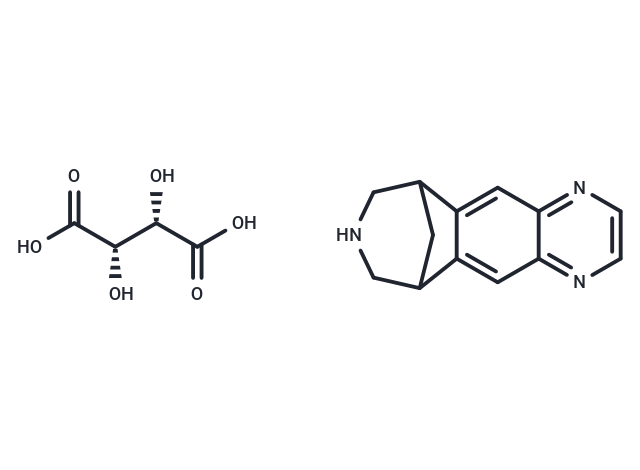Shopping Cart
- Remove All
 Your shopping cart is currently empty
Your shopping cart is currently empty

Varenicline Tartrate (CP 526555-18) is a benzazepine derivative that functions as an ALPHA4/BETA2 NICOTINIC RECEPTOR partial agonist. It is used for SMOKING CESSATION.

| Pack Size | Price | Availability | Quantity |
|---|---|---|---|
| 5 mg | $30 | In Stock | |
| 10 mg | $40 | In Stock | |
| 25 mg | $73 | In Stock | |
| 50 mg | $123 | In Stock | |
| 100 mg | $197 | In Stock |
| Description | Varenicline Tartrate (CP 526555-18) is a benzazepine derivative that functions as an ALPHA4/BETA2 NICOTINIC RECEPTOR partial agonist. It is used for SMOKING CESSATION. |
| In vitro | Varenicline is a partial agonist with 45% of nicotine's maximal efficacy atalpha4beta2 nAChRs in HEK cells expressing nAChRs. [1] Varenicline is a potent, partial agonist at alpha4beta2 receptors, with an EC50 of 2.3 mM and an efficacy (relative to acetylcholine) of 13.4%. Varenicline has lower potency and higher efficacy at alpha3beta4 receptors, with an EC50 of 55 mM and an efficacy of 75%. [2] |
| In vivo | Varenicline has significantly lower (40-60%) efficacy than nicotine in stimulating [(3)H]-dopamine release from rat brain slices in vitro and in increasing dopamine release from rat nucleus accumbens in vivo, while it is more potent than Nicotine. Varenicline effectively attenuates the nicotine-induced dopamine release to the level of the effect of Varenicline alone, consistent with partial agonism. Varenicline reduces nicotine self-administration in rats and supports lower self-administration break points than nicotine. [1] Varenicline dose-dependently reduces nicotine self-administration and attenuates both nicotine prime and combined nicotine prime plus nicotine-paired cue-induced reinstatement. [3] Varenicline, a partial agonist at thealpha4beta2 nAChRs, reduces nicotine intake and was recently approved as a smoking cessation aid. Varenicline selectively reduces ethanol but not sucrose seeking using an operant self-administration drinking paradigm and also decreases voluntary ethanol but not water consumption in animals chronically exposed to ethanol for 2 months before Varenicline treatment. [4] |
| Kinase Assay | Kinase inhibition: Vandetanib is incubated with enzyme, 10 mM MnCl2, and 2 μM ATP in 96-well plates coated with a poly(Glu, Ala, Tyr) 6:3:1 random copolymer substrate. Phosphorylated tyrosine is then detected by sequential incubation with a mouse IgG anti-phosphotyrosine 4 g10 antibody, a horseradish peroxidase-linked sheep antimouse immunoglobulin antibody, and 2,2′-azino-bis(3-ethylbenzthiazoline-6-sulfonic acid). This methodology is adapted to examine selectivity versus tyrosine kinases associated with EGFR, PDGFRβ, Tie-2, FGFR1, c-kit, erbB2, IGF-1R, and FAK. All enzyme assays (tyrosine or serine-threonine) used appropriate ATP concentrations at or just below the respective Km (0.2–14 μM). Selectivity versus serine-threonine kinases (CDK2, AKT, and PDK1) is examined using a relevant scintillation proximity-assay (SPA) in 96-well plates. CDK2 assays contained 10 mM MnCl2, 4.5 μM ATP, 0.15 μCi of [γ-33 P]ATP/reaction, 50 mM HEPES (pH 7.5), 1 mM DTT, 0.1 mM sodium orthovanadate, 0.1 mM sodium fluoride, 10 mM sodium glycerophosphate, 1 mg/mL BSA fraction V, and a retinoblastoma substrate (part of the retinoblastoma gene, 792–928, expressed in a glutathione S-transferase expression system; 0.22 μM final concentration). Reactions are allowed to proceed at room temperature for 60 minutes before quenching for 2 hours with 150 μL of a solution containing EDTA (62 mM final concentration), 3 μg of a rabbit immunoglobulin anti-glutathione S-transferase antibody and protein A SPA-polyvinyltoluene beads (0.8 mg/reaction). Plates are then sealed, centrifuged (1200× g for 5 minutes), and counted on a Microplate scintillation counter for 30 seconds. |
| Alias | CP 526555-18, Chantix tartrate, Champix tartrate |
| Molecular Weight | 361.35 |
| Formula | C13H13N3·C4H6O6 |
| Cas No. | 375815-87-5 |
| Smiles | O[C@@H]([C@H](O)C(O)=O)C(O)=O.C1C2CNCC1c1cc3nccnc3cc21 |
| Relative Density. | no data available |
| Storage | Powder: -20°C for 3 years | In solvent: -80°C for 1 year | Shipping with blue ice. | |||||||||||||||
| Solubility Information | DMSO: 3.61 mg/mL (9.99 mM), Sonication is recommended. | |||||||||||||||
Solution Preparation Table | ||||||||||||||||
DMSO
| ||||||||||||||||

Copyright © 2015-2025 TargetMol Chemicals Inc. All Rights Reserved.